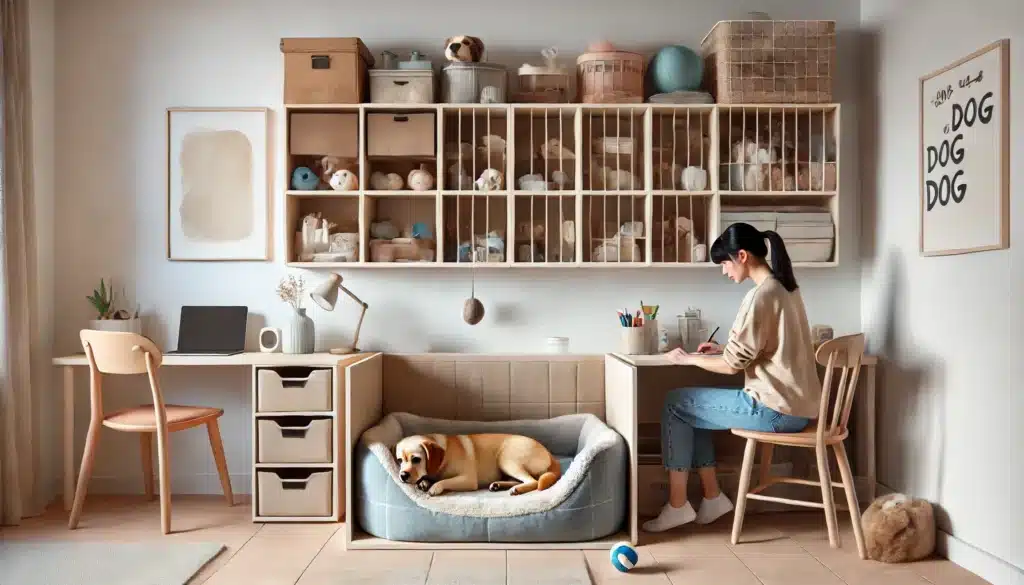Living in a small apartment doesn’t mean your dog has to miss out on comfort, exercise, or happiness. With the right setup, routine, and creativity, even the tiniest space can become a dog-friendly haven where your furry companion can thrive.
In this article, we’ll share practical, effective tips for keeping dogs happy, healthy, and well-behaved in apartments — no backyard required.
Can Dogs Really Be Happy in Apartments?
Yes! Dogs don’t need a big house — they need engagement, structure, and comfort.
With consistent mental stimulation, exercise, and a cozy environment, dogs of all sizes (even large breeds) can live perfectly happy lives in apartments.
The key is knowing how to maximize your space and routine to meet their physical and emotional needs.
1. Choose the Right Dog for Apartment Life (If You’re Still Deciding)
While any dog can adapt with the right care, some breeds are naturally more suited to smaller spaces.
Typically apartment-friendly dogs:
- French Bulldogs
- Cavalier King Charles Spaniels
- Greyhounds (surprisingly calm indoors!)
- Dachshunds
- Pugs
- Shih Tzus
- Mixed-breed rescues with calm temperaments
That said, even a high-energy breed can thrive in an apartment with proper attention and outlet for energy.
2. Stick to a Daily Exercise Routine
Lack of space means you’ll need to replace backyard play with intentional walks and activities.
A basic routine:
- Morning walk: 20–30 minutes for potty + movement
- Midday play or quick walk: Mental refresh
- Evening walk: 30+ minutes, plus sniff time or training
- Indoor activities: Throughout the day
Bonus tip: Let your dog sniff! A “sniffari” walk is mentally exhausting in a good way.
3. Create a Defined Dog Zone
Even in small apartments, your dog needs a “place” of their own — a cozy corner with a bed, toys, and calm energy.
- Use rugs, mats, or small crates to define their spot
- Keep it away from noisy appliances and foot traffic
- Make it a calm, positive space (not punishment-based)
This helps with training, confidence, and alone-time comfort.
4. Use Vertical Space and Smart Storage
Your space is limited — so go vertical.
- Install wall shelves or cubbies for storing dog gear
- Use under-bed storage bins for treats, grooming tools, and food
- Add hooks by the door for leashes and poop bags
- Store toys in baskets and rotate them weekly
A tidy home = less stress for both of you.
5. Manage Potty Breaks Strategically
Apartment living requires planning potty breaks — especially if stairs, elevators, or weather make things tricky.
Tips:
- Set a consistent potty schedule
- Learn your dog’s cues
- Use pee pads or grass patches on balconies for emergencies (especially useful for puppies or seniors)
- Always reward going potty in the right place
6. Minimize Barking and Noise
Thin walls and neighbors make barking a top concern for apartment dwellers.
Tips to reduce barking:
- Block visual triggers (curtains or window film)
- Play calming music or white noise when you leave
- Desensitize your dog to door sounds or neighbors
- Teach the “Quiet” command with positive reinforcement
- Avoid yelling — it often increases excitement
If separation anxiety is causing vocalization, address the root issue with training and structure.
7. Enrich Their Mind Daily
Mental stimulation is just as important as physical exercise — especially in small spaces.
Great indoor activities:
- Food puzzle toys
- Hide-and-seek with treats
- Obedience or trick training
- Scent games (“Find it!”)
- Frozen Kongs or long-lasting chews
- Lick mats to promote calmness
Aim for 10–20 minutes of mental games per day.
8. Take Advantage of Outdoor Spaces
- Visit nearby dog parks, if safe and well-managed
- Explore new walking routes for variety
- Try dog-friendly patios or cafés
- Check if your apartment complex has a pet relief area or lawn
Regular outdoor exposure reduces indoor boredom and improves behavior.
9. Be a Respectful Neighbor
- Clean up after your dog — always
- Keep barking to a minimum
- Avoid using shared spaces (like hallways) for off-leash play
- Train your dog to walk calmly past other pets or people
Being a great dog owner includes being a great neighbor.
10. Set Clear Boundaries Inside
Small spaces can make it easy for your dog to develop bad habits — like jumping on counters, begging at the table, or following you everywhere.
Use training cues like:
- “Place” (go to your bed/mat)
- “Wait” (stay until released)
- “Leave it” (ignore distractions)
- “Quiet” (stop barking)
Consistency = calm and respectful behavior.
Final Thoughts: Apartment Dogs Can Thrive
You don’t need a yard or a big house to raise a happy, healthy dog. With structure, creativity, and love, you can create a full and fulfilling life for your furry friend — right there in your apartment.
Keep them stimulated. Give them routine. Make space for rest and play. And remember — what dogs really want is time, connection, and a calm, safe space beside you.







